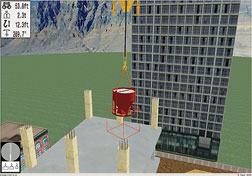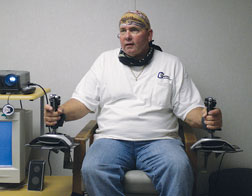 Tower Crane School of Phoenix
|
 Tower Crane School of Phoenix
Gray sits in the ‘electric chair’ at his crane school.
|
Students who climb into Ronald Gray’s “electric chair” are usually in for a shocking experience. The chair, wired up to a couple of joysticks and a laptop computer, is not a mode of punishment for students who misbehave, but a surprisingly useful simulation tool that helps potential operators sharpen their skills. And it costs a lot less than the real thing.
Similar to flight-simulators for jumbo-jet pilots, heavy-equipment programs help operators learn from mistakes in the virtual world without placing themselves in harm’s way in the real world. “They are neat pieces of equipment,” says Shawn King, environmental safety, health and security manager for Overland Park, Kan.-based contractor Black & Veatch.
Construction simulators have come a long way in just a few years. The heavy, clunky, cab-console programs of a decade ago are in many schools being replaced by realistic programs that run on a laptop. Costs also have come down, from tens of thousands of dollars to just a few thousand. “The evolution of computing technology has allowed this,” says Mike Keffer, marketing manager for Montreal-based Simlog, which sells a tower-crane program for $3,500 and offers nine other heavy-equipment modules costing up to $10,000. In addition to unions and professional trainers, employers use the programs to assess worker skills, says Keffer.
|
At Gray’s crane school in Apache Junction, Ariz., an assistant dims the lights and switches on a projector. Inexpensive gaming joysticks mimic actual controls. The session begins with basic load-control exercises and moves on to heavy lifting, such as pouring concrete, hanging steel and setting air-handlers. At the end of each level, students’ progress is recorded.
 Related Links:
Related Links: 
Post a comment to this article
Report Abusive Comment